height adjustment RENAULT TWINGO 2017 3.G Owners Manual
[x] Cancel search | Manufacturer: RENAULT, Model Year: 2017, Model line: TWINGO, Model: RENAULT TWINGO 2017 3.GPages: 228, PDF Size: 6.76 MB
Page 18 of 228
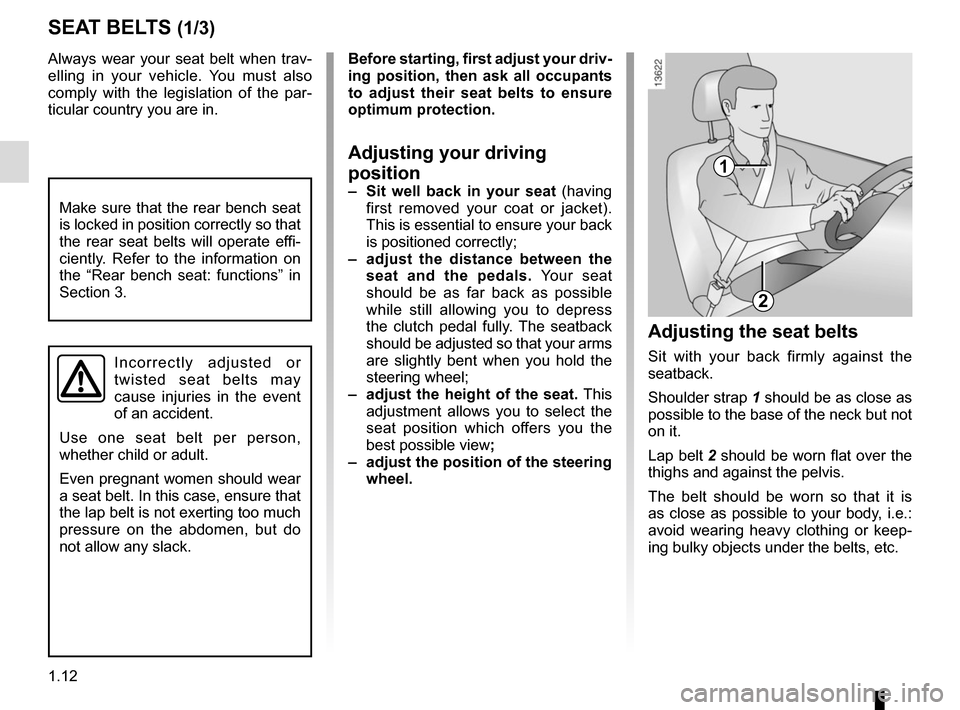
1.12
Always wear your seat belt when trav-
elling in your vehicle. You must also
comply with the legislation of the par-
ticular country you are in.
SEAT BELTS (1/3)
1
2
Incorrectly adjusted or
twisted seat belts may
cause injuries in the event
of an accident.
Use one seat belt per person,
whether child or adult.
Even pregnant women should wear
a seat belt. In this case, ensure that
the lap belt is not exerting too much
pressure on the abdomen, but do
not allow any slack.
Before starting, first adjust your driv-
ing position, then ask all occupants
to adjust their seat belts to ensure
optimum protection.
Adjusting your driving
position
– Sit well back in your seat (having
first removed your coat or jacket).
This is essential to ensure your back
is positioned correctly;
– adjust the distance between the seat and the pedals. Your seat
should be as far back as possible
while still allowing you to depress
the clutch pedal fully. The seatback
should be adjusted so that your arms
are slightly bent when you hold the
steering wheel;
– adjust the height of the seat. This
adjustment allows you to select the
seat position which offers you the
best possible view ;
– adjust the position of the steering
wheel.
Adjusting the seat belts
Sit with your back firmly against the
seatback.
Shoulder strap 1 should be as close as
possible to the base of the neck but not
on it.
Lap belt 2 should be worn flat over the
thighs and against the pelvis.
The belt should be worn so that it is
as close as possible to your body, i.e.:
avoid wearing heavy clothing or keep-
ing bulky objects under the belts, etc.
Make sure that the rear bench seat
is locked in position correctly so that
the rear seat belts will operate effi-
ciently. Refer to the information on
the “Rear bench seat: functions” in
Section 3.
Page 28 of 228
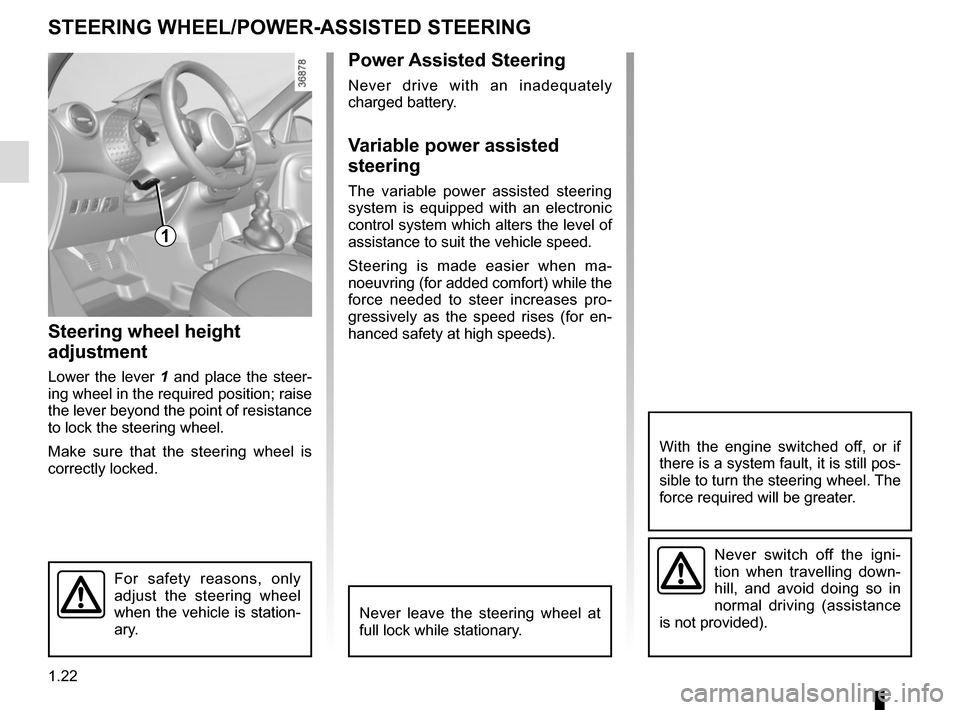
1.22
Power Assisted Steering
Never drive with an inadequately
charged battery.
Variable power assisted
steering
The variable power assisted steering
system is equipped with an electronic
control system which alters the level of
assistance to suit the vehicle speed.
Steering is made easier when ma-
noeuvring (for added comfort) while the
force needed to steer increases pro-
gressively as the speed rises (for en-
hanced safety at high speeds).
Steering wheel height
adjustment
Lower the lever 1 and place the steer-
ing wheel in the required position; raise
the lever beyond the point of resistance
to lock the steering wheel.
Make sure that the steering wheel is
correctly locked.
For safety reasons, only
adjust the steering wheel
when the vehicle is station-
ary.
STEERING WHEEL/POWER-ASSISTED STEERING
1
Never switch off the igni-
tion when travelling down-
hill, and avoid doing so in
normal driving (assistance
is not provided).
With the engine switched off, or if
there is a system fault, it is still pos-
sible to turn the steering wheel. The
force required will be greater.
Never leave the steering wheel at
full lock while stationary.
Page 68 of 228
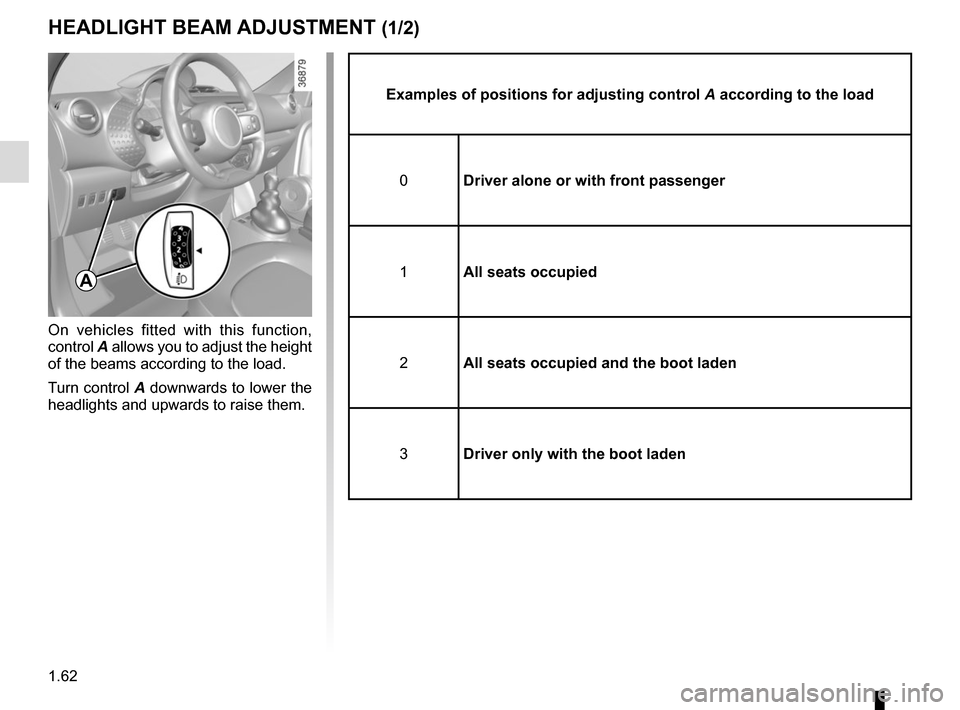
1.62
HEADLIGHT BEAM ADJUSTMENT (1/2)
On vehicles fitted with this function,
control A allows you to adjust the height
of the beams according to the load.
Turn control A downwards to lower the
headlights and upwards to raise them.
Examples of positions for adjusting control A according to the load
0 Driver alone or with front passenger
1 All seats occupied
2 All seats occupied and the boot laden
3 Driver only with the boot laden
A
Page 185 of 228
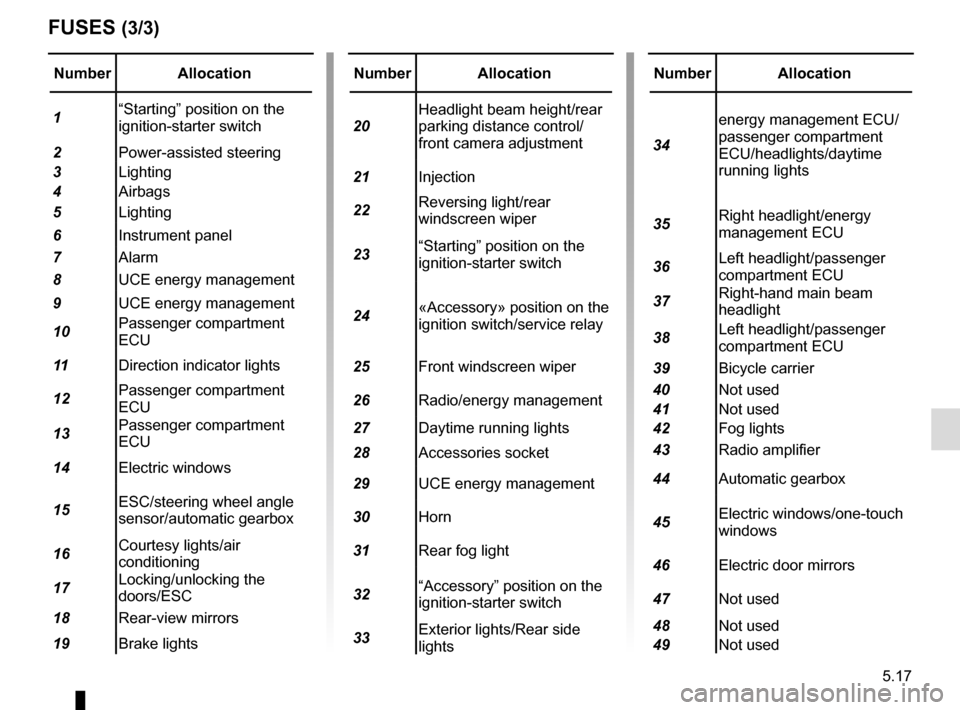
5.17
Number Allocation
1 “Starting” position on the
ignition-starter switch
2 Power-assisted steering
3 Lighting
4 Airbags
5 Lighting
6 Instrument panel
7 Alarm
8 UCE energy management
9 UCE energy management
10 Passenger compartment
ECU
11 Direction indicator lights
12 Passenger compartment
ECU
13 Passenger compartment
ECU
14 Electric windows
15 ESC/steering wheel angle
sensor/automatic gearbox
16 Courtesy lights/air
conditioning
17 Locking/unlocking the
doors/ESC
18 Rear-view mirrors
19 Brake lights
FUSES (3/3)
Number Allocation
20 Headlight beam height/rear
parking distance control/
front camera adjustment
21 Injection
22 Reversing light/rear
windscreen wiper
23 “Starting” position on the
ignition-starter switch
24 «Accessory» position on the
ignition switch/service relay
25 Front windscreen wiper
26 Radio/energy management
27 Daytime running lights
28 Accessories socket
29 UCE energy management
30 Horn
31 Rear fog light
32 “Accessory” position on the
ignition-starter switch
33 Exterior lights/Rear side
lightsNumber Allocation
34 energy management ECU/
passenger compartment
ECU/headlights/daytime
running lights
35 Right headlight/energy
management ECU
36 Left headlight/passenger
compartment ECU
37 Right-hand main beam
headlight
38 Left headlight/passenger
compartment ECU
39 Bicycle carrier
40 Not used
41 Not used
42 Fog lights
43 Radio amplifier
44 Automatic gearbox
45 Electric windows/one-touch
windows
46 Electric door mirrors
47 Not used
48 Not used
49 Not used
Page 222 of 228
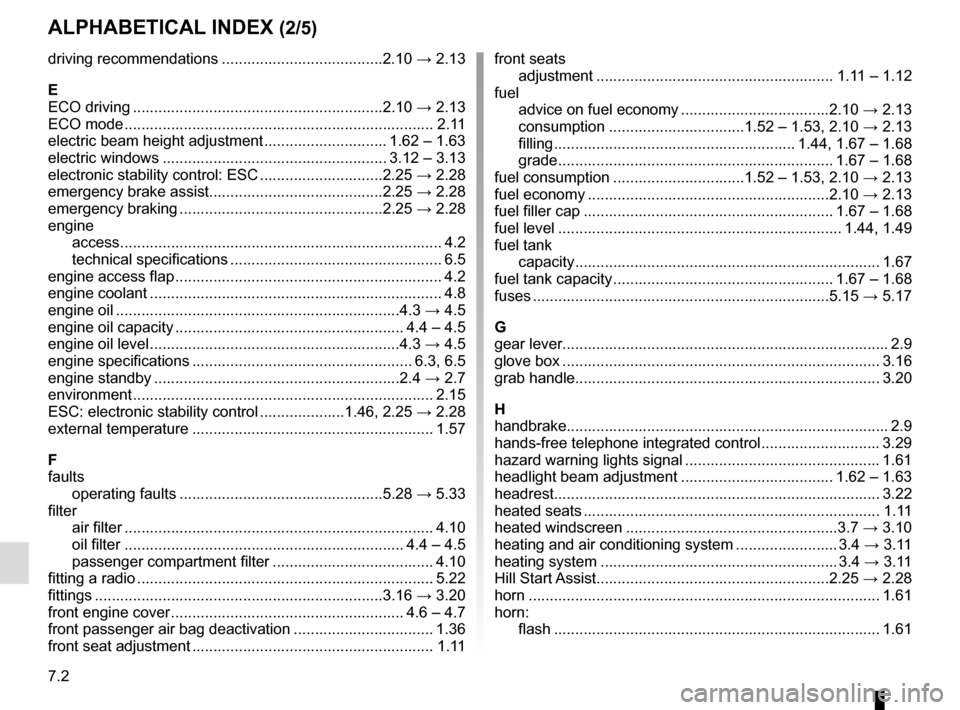
7.2
ALPHABETICAL INDEX (2/5)
driving recommendations ......................................2.10 → 2.13
E
ECO driving ...........................................................2.10 → 2.13
ECO mode ........................................................................\
. 2.11
electric beam height adjustment ............................. 1.62 – 1.63
electric windows ..................................................... 3.12 – 3.13
electronic stability control: ESC .............................2.25 → 2.28
emergency brake assist.........................................2.25 → 2.28
emergency braking ................................................2.25 → 2.28
engine access .................................................................\
........... 4.2
technical specifications .................................................. 6.5
engine access flap ............................................................... 4.2
engine coolant ..................................................................... 4.8
engine oil ...................................................................4.3 → 4.5
engine oil capacity ...................................................... 4.4 – 4.5
engine oil level ...........................................................4.3 → 4.5
engine specifications .................................................... 6.3, 6.5
engine standby ..........................................................2.4 → 2.7
environment ............................................................\
........... 2.15
ESC: electronic stability control ....................1.46, 2.25 → 2.28
external temperature ......................................................... 1.57
F
faults operating faults ................................................5.28 → 5.33
filter air filter ........................................................................\
. 4.10
oil filter .................................................................. 4.4 – 4.5
passenger compartment filter ...................................... 4.10
fitting a radio ...................................................................... 5.22
fittings ...............................................................\
.....3.16 → 3.20
front engine cover ....................................................... 4.6 – 4.7
front passenger air bag deactivation ................................. 1.36
front seat adjustment ......................................................... 1.11 front seats
adjustment ........................................................ 1.11 – 1.12
fuel advice on fuel economy ...................................2.10 → 2.13
consumption ................................1.52 – 1.53, 2.10 → 2.13
filling ......................................................... 1.44, 1.67 – 1.68
grade ................................................................. 1.67 – 1.68
fuel consumption ...............................1.52 – 1.53, 2.10 → 2.13
fuel economy .........................................................2.10 → 2.13
fuel filler cap ........................................................... 1.67 – 1.68
fuel level ................................................................... 1.44, 1.49
fuel tank capacity ...............................................................\
......... 1.67
fuel tank capacity .................................................... 1.67 – 1.68
fuses ..................................................................\
....5.15 → 5.17
G
gear lever........................................................................\
..... 2.9
glove box ........................................................................\
... 3.16
grab handle........................................................................\
3.20
H
handbrake........................................................................\
.... 2.9
hands-free telephone integrated control ............................ 3.29
hazard warning lights signal .............................................. 1.61
headlight beam adjustment .................................... 1.62 – 1.63
headrest........................................................................\
..... 3.22
heated seats ...................................................................... 1.11
heated windscreen ..................................................3.7 → 3.10
heating and air conditioning system ........................ 3.4 → 3.11
heating system ........................................................ 3.4 → 3.11
Hill Start Assist.......................................................2.25 → 2.28
horn ...................................................................\
................ 1.61
horn: flash ..................................................................\
........... 1.61